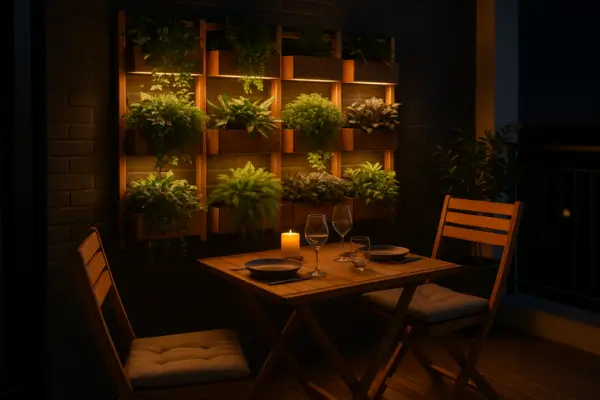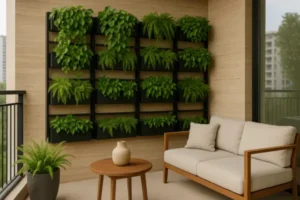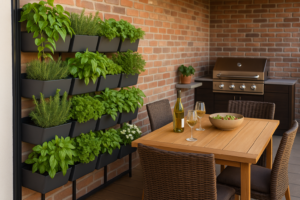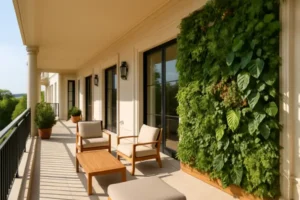If you’ve ever imagined turning your balcony into a magical setting for night dinners, modular vertical gardens with built-in lighting might be exactly what you’re looking for. They bring together smart design, green aesthetics, and a touch of evening charm that’s hard to resist.
These garden systems aren’t just pretty to look at—they’re modular, meaning you can adjust them to fit even the smallest balconies. And when lighting is built right into the structure, you get an inviting glow that makes your dinners feel like an experience, not just a meal.
Here, we go beyond the superficial ideas and show you how to make the most of vertical gardens with integrated lights. From layout tips to plant selection and nighttime ambiance, you’ll find everything you need to create a functional and beautiful space—whether in a high-rise apartment or a cozy studio with a modest balcony.
Modular Vertical Gardens with Built-In Lighting: Why They Work So Well for Evening Spaces
The reason modular vertical gardens with built-in lighting have become popular is simple—they combine flexibility with beauty in a way that transforms small spaces.
For people living in apartments or homes with limited outdoor areas, the challenge is always the same: how to create a cozy, functional setting that doesn’t take up too much room. That’s where modular vertical gardens shine.
The Concept Behind the Modular Design
Modular systems are built with adaptability in mind. You can stack, reconfigure, or extend them to fit the size of your wall or the shape of your balcony. Unlike traditional garden setups, these vertical structures rise rather than spread out.
They maximize vertical space while keeping the floor clear, which is especially useful during dinners where every inch matters.
More than just a space-saver, the modular layout allows you to organize plants by type, watering needs, or decorative purpose. Herbs in one row, ornamentals in another—it’s structure and creativity working together.
Built-In Lighting That Does More Than Shine
Integrated lighting isn’t only about visibility. It sets the mood. It draws attention to textures, colors, and leaf shapes that you wouldn’t notice during the day. Whether it’s soft warm LEDs that wrap around each plant tier, or subtle spotlights highlighting select pots, the effect is immersive.

Built-in lighting also has a practical side. You won’t need to install separate fixtures or run extension cords through your balcony. Most systems run on low-voltage LED or solar-powered strips, which are energy-efficient and easy to manage.
Why This Combination Works So Well for Dinners
When you sit down for a meal, atmosphere matters. The gentle glow from the lighting, paired with the green freshness of the vertical plants, turns an ordinary balcony into a dining nook that feels both private and elevated. It’s ideal for romantic dinners, casual evenings with friends, or even just a moment of peace after a long day.
Many people underestimate the power of ambiance. A meal tastes different when your surroundings feel thoughtful. That’s the unspoken strength of combining vertical gardens with light—it changes how you feel in the space.
Choosing the Right Structure for Your Balcony Size and Style
When planning modular vertical gardens with built-in lighting, one of the first decisions you’ll face is choosing the right structure. Not every balcony is the same, and that’s exactly why the modular approach is so powerful—it adapts. But even with that flexibility, there are details that make all the difference in creating a space that truly works for your lifestyle.
Start by Measuring Your Space
Before anything else, get a tape measure and note the height, width, and depth of your usable wall space. Balconies under 2 meters wide might benefit from narrow stacked modules, while larger spaces allow for wider layouts with tiered lighting effects.
Make sure to account for movement around the area. Can someone comfortably pull out a chair without bumping into the plants? Can you walk through the space without brushing against the garden after dark?
Picking the Right Frame Material
Frame material affects both look and longevity. Some common options include:
- Powder-coated metal: sleek and modern, holds up well in outdoor conditions
- Treated wood: adds warmth and character, perfect for a rustic or natural feel
- Recycled plastic: lightweight and often more affordable
The material also affects how lighting will be installed. For instance, wooden frames allow for embedded wiring or hidden LED strips, while metal grids might use clip-on or magnet-based lights.
Matching Garden Style to Balcony Vibe
If you’re browsing balcony garden ideas, you’ve likely seen everything from lush jungle looks to minimalist herb walls. The key is to choose a style that complements the way you already use your space. Ask yourself:
- Do you want this to be a visual centerpiece or a subtle green accent?
- Will you grow herbs, flowers, vines—or a mix?
- Do you prefer symmetry, or a more natural, flowing look?
Answering these questions helps guide not only the layout but the kind of lighting you’ll need—soft glows for ambience, or direct beams for functional plant care at night.
How to Install Lighting That Complements Your Garden and Dinner Setup
Lighting is the secret ingredient that transforms a vertical garden from “just decorative” into something truly memorable. When building modular vertical gardens with built-in lighting, it’s not just about adding brightness—it’s about adding personality.
And the right balcony lighting setup will make your dinners feel cozy, intimate, and visually stunning.
Where to Place the Lights: Layering Matters
When planning your setup, think in layers. Just as you wouldn’t light an entire room with a single bulb, your vertical garden benefits from multiple sources working together.
Here’s a simple way to approach it:
- Top-down lighting: Soft LED strips or spotlights installed along the upper frame cast a gentle glow downward, highlighting the plants without being harsh.
- Mid-level accents: Place small warm-toned LEDs near the middle tier to illuminate leaf textures and provide ambiance at eye level.
- Bottom highlights: If your garden includes storage or a base planter box, subtle lighting underneath can visually anchor the entire setup and make it look intentional.
This kind of layered lighting brings depth and makes your plants stand out, especially in the evening.
Choosing the Right LED Garden Lights
Not all LEDs are created equal. Here’s what to consider when selecting lights for your vertical garden:
- Warm white tone (2700K–3000K): Perfect for evening dinners, adds a golden glow.
- Water-resistant design: Essential for any balcony exposed to rain or humidity.
- Low voltage or solar-powered: Safer, more energy-efficient, and easier to install without electrical work.
- Flexible strips or puck lights: Easy to shape around corners or install behind planters for a soft backlight effect.
When installing, always test placement at night before finalizing. Sometimes even small shifts in angle can change how your space feels.
Syncing Lights with the Mood of the Meal
Lighting isn’t just for the garden—it shapes the entire dinner experience. Want something romantic? Dimmer-compatible lights let you lower the intensity. Planning a casual night with friends? Add string lights or lanterns to the mix for a relaxed vibe.
The best part is how the lighting blends with your vertical garden to create a setting that feels personal and alive. It’s not staged—it’s your space, tailored to how you actually live.
Best Plants to Use in Vertical Gardens with Lighting: Looks, Function, and Night Appeal
A beautiful garden isn’t just about structure—it’s about what grows inside it. When creating modular vertical gardens with built-in lighting, choosing the right plants can make all the difference in how the space looks, smells, and feels after sunset.
The Role of Light in Plant Selection
While the built-in lighting enhances visual appeal, it’s typically not strong enough to replace natural sunlight for plant growth. That means your plant choices should fit two criteria:
- Thrive in indirect or partial light (since most balconies get limited sun)
- Look great under warm-toned LEDs at night
Fortunately, there are plenty of species that meet both needs. And many of them add color, texture, or fragrance—perfect for evening meals outdoors.
Best Plants for Balcony Garden Ambiance
Here are a few favorites that combine beauty, ease, and compatibility with vertical setups:
- Golden pothos (Epipremnum aureum): Low-maintenance, grows fast, and glows under warm lighting.
- English ivy (Hedera helix): Great for creating a cascading effect; handles shade well.
- Lavender: Adds a soft scent that enhances the dining mood.
- Mint and basil: Functional and fresh—pluck leaves straight into your dinner.
- Ferns (like Boston fern): Ideal for texture and thrive in low light.
- Begonias: Their colorful leaves reflect light beautifully in the evening.
Low-Light Plants for Vertical Gardens
If your balcony doesn’t get much direct sun, consider these resilient options:
- Peace lily (Spathiphyllum): Tolerates low light and adds elegant blooms.
- ZZ plant (Zamioculcas zamiifolia): Virtually unkillable and sculptural in shape.
- Spider plant: A classic that adapts easily to many conditions.
- Calathea varieties: Striking leaf patterns that look almost painted under LEDs.
These plants don’t just survive—they thrive in shaded balconies with ambient lighting, making them perfect companions for your night garden.
One Extra Tip
Always group plants with similar watering and light needs together. That way, your garden stays healthier, and your maintenance routine gets simpler.
Turning a Simple Balcony into a Multifunctional Retreat
One of the most underrated benefits of modular vertical gardens with built-in lighting is how they help you completely reimagine your balcony. What starts as a small corner for a few plants can quickly become a space where you read, dine, work, or unwind—especially when the setup is thoughtfully designed for flexibility.
From Dinner Nook to Morning Coffee Spot
During the evening, your garden glows softly while you enjoy a peaceful meal. But when morning comes, the same setup becomes a bright and calm place to start your day. You don’t need to rearrange anything—just switch the lighting off, pull the curtain open, and your space feels new again.
Add a small café-style table, a foldable chair, and a soft cushion, and you’re set for breakfast with a view. Some people even use vertical gardens as a natural divider, separating the dining corner from a mini workspace.
Cozy Balcony Ideas That Maximize Comfort
If you’re looking for cozy balcony ideas that go beyond plants and lights, consider these easy upgrades:
- Foldable or stackable furniture: Saves space without sacrificing function
- Outdoor rug: Instantly adds warmth and a sense of “room” to the area
- Throw blankets and floor cushions: Ideal for cool nights and casual seating
- A small bookshelf or shelf corner: Store candles, plants, or even your laptop
The vertical garden acts as a visual anchor—it gives the space identity, especially when combined with a soft lighting scheme. That makes the rest of your design feel intentional and inviting.
Small Balcony Transformation That Feels Big
You don’t need a large footprint to create something meaningful. In fact, some of the most stunning small balcony transformation projects rely on nothing more than one vertical garden, a smart seating choice, and a couple of warm lights.
What makes the change feel big is the way everything works together: plants soften the mood, light adds emotion, and the layout invites you to linger. That’s the magic of designing with intention, even in a compact space.
Creating a Smart Lighting Routine for Your Vertical Garden
One feature that takes modular vertical gardens with built-in lighting to the next level is automation. With a few simple tools, you can schedule your lights to turn on exactly when the sun goes down—even if you’re not home. The result? Your balcony is always ready for dinner, relaxation, or even surprise guests.
Why Automate the Lighting?
Imagine coming home after a long day to a balcony already glowing softly, your plants subtly lit, and the atmosphere ready. No switches to flip. No setup to adjust. That’s the beauty of automated garden lights—they give you consistency, convenience, and a touch of magic.
Plus, automation extends the lifespan of your LEDs by preventing overuse. You’re not leaving them on all night by accident. They know when to stop.
Simple Tools for Smart Balcony Lighting
You don’t need an electrician to set this up. Many smart lighting tools are plug-and-play. Here’s what you can use:
- Smart plugs: Connect your LED lights to a Wi-Fi enabled smart plug. Use a mobile app to set timers, adjust brightness, or sync with sunset times.
- Light sensors: Attach a small sensor that triggers the lights as soon as it gets dark. Ideal for solar-powered or low-voltage setups.
- Voice assistants (Alexa, Google Home, etc.): Combine smart plugs with your home assistant to turn lights on or off using voice commands.
These systems are especially useful for balconies that double as dining spaces. No fumbling with switches or remotes while carrying dishes or drinks.
Setting the Perfect Routine
You can start with something as simple as:
- On at 6:30 PM, just before dusk
- Off at 10:30 PM, after dinner or relaxation time
Or go a step further by syncing the lights to sunrise/sunset times, which adjust daily. Many apps let you control this with a single tap, and some even let you change the lighting color or intensity for different moods.
It’s a small setup—but it makes a big difference in how your balcony feels and functions.
Keeping It Fresh: Maintenance Tips for Your Garden and Built-In Lighting
Once your modular vertical gardens with built-in lighting are set up, the hard part is over—but the small habits you build afterward will keep everything looking just as stunning weeks and months down the line. The trick is to make maintenance part of your routine without it feeling like a chore.
Simple Balcony Garden Maintenance that Works
Your vertical garden may not take up much space, but the plants still need attention. Here’s how to stay on top of things:
- Water smart: Since vertical gardens dry out faster than traditional pots, check soil moisture often. A small watering can with a long spout makes this easier, especially for higher levels.
- Trim regularly: Remove yellowing leaves, trim excess growth, and guide vines to grow along the intended path. This keeps the garden tidy and the lighting effect consistent.
- Rotate pots if possible: Some modular systems let you remove and rotate containers. This is helpful to balance sun exposure if your balcony has uneven light.
It only takes 10–15 minutes a week, but it makes a visible difference. Plants stay vibrant, and the entire structure feels well-cared-for.
LED Light Care Tips to Keep the Glow Going
While LED lights are known for their long lifespan, outdoor use does require a bit of awareness. Here are a few easy practices:
- Wipe dust and water spots: Use a dry microfiber cloth once a month to gently clean the LED surfaces. This keeps the light clear and soft, not dim or uneven.
- Check for loose wires or connectors: Especially after heavy rain or strong wind, it’s good to give the lighting setup a once-over to ensure nothing shifted.
- Avoid overloading: Don’t plug too many lights into a single outlet or smart plug. Spread the load if needed to prevent short circuits.
A bonus tip? Always have a few extra light strips or clips on hand. They’re cheap, easy to store, and can be swapped out in minutes if something dims or flickers.
Final Thoughts
Bringing modular vertical gardens with built-in lighting into your balcony is more than a design choice—it’s a way to reclaim small spaces and turn them into meaningful moments. Whether you’re hosting dinner for two or simply winding down after work, the soft lights and living greenery create a setting that feels like yours.
What makes this setup so powerful is the balance between beauty and function. With the right structure, thoughtful lighting, and plant choices that match your rhythm, your balcony becomes an extension of your lifestyle—cozy, flexible, and always welcoming.
Now that you’ve seen what’s possible, it’s your turn. Start small if you need to. Add one row of plants. One strip of lights. Then build from there. Before long, you’ll have a space that doesn’t just look good at night—it feels like home.



